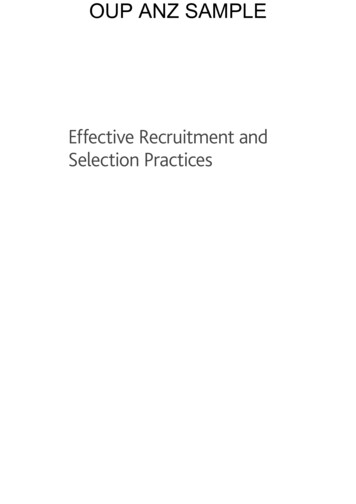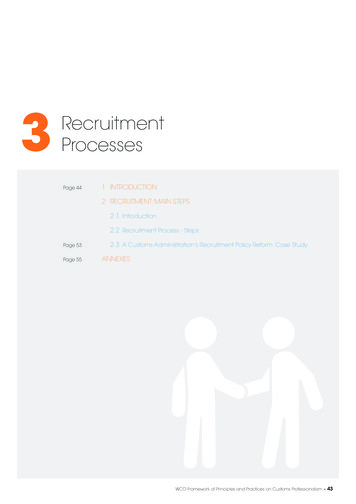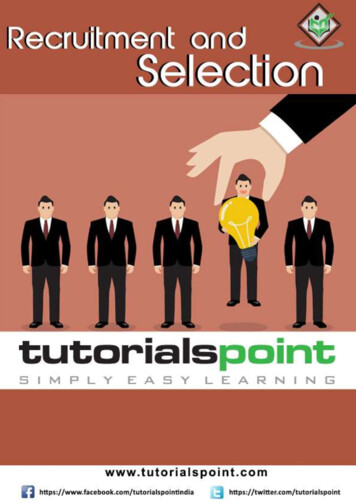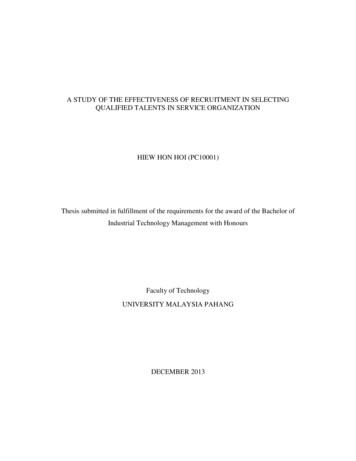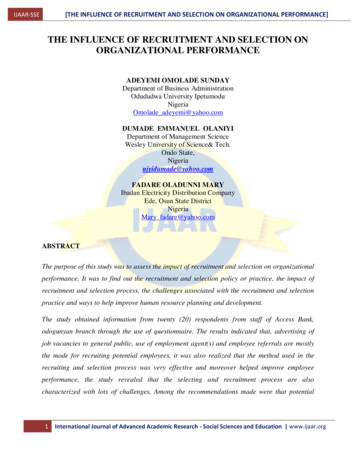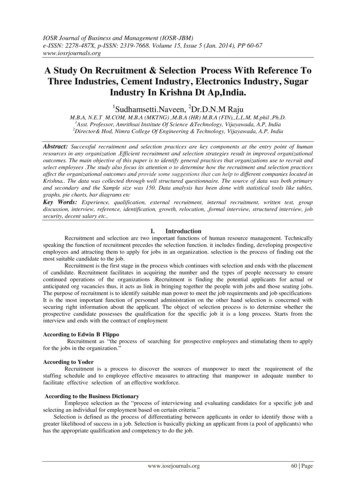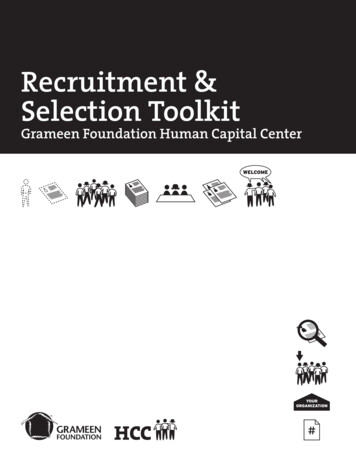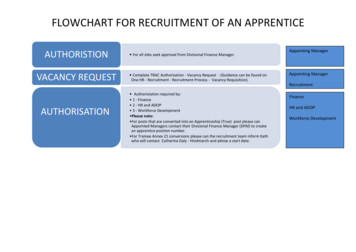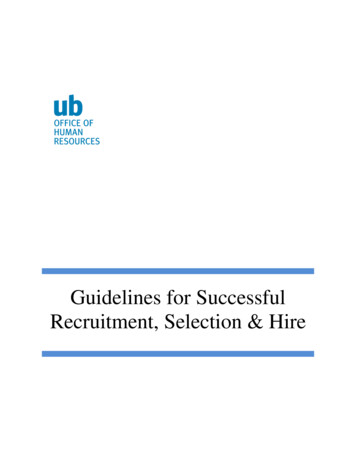
Transcription
Guidelines for SuccessfulRecruitment, Selection & Hire
TABLE OF CONTENTSUB Equal Opportunity Policy . .3Introduction .4Legal Considerations .5Pre-Employment Inquiry GuidelinesWriting a Successful Recruitment Posting .8Sourcing Candidates .8Search Committees . 10Preparing for the Interview .11Screening ApplicantsReview the PositionIdentify the Selection CriteriaPrepare Interview QuestionsFactors to Consider Before the InterviewConducting the Interview .16Special Interview Considerations for All CandidatesInterviewing Under ADAPre-Employment Inquiries Concerning AttendancePre-Employment Inquiries Concerning Workers’ CompensationPre-Employment/Reference Checks .19Points to ConsiderEvaluating the CandidatesPost-Interview Follow Up .22Extending the Job OfferPrepare for the New Employee’s First DayInterview Documentation and Record RetentionResource Material .23Competencies and Achievement Levels by Job RoleInterviewer's Self-Assessment ChecklistSample Interview QuestionsUB Reference/Credentials Checklist TemplateNotes .48
EQUAL OPPORTUNITY POLICYThe University of Baltimore does not discriminate on the basis of sex, gender, race, religion, age,disability, national origin, ethnicity, sexual orientation, gender identity, or other legally protectedcharacteristics in its programs, activities, or employment practices.Further, the University, through its employment practices and procedures recruits and employs qualifiedpersonnel for all of its diverse activities and at all of its facilities. The University provides equalopportunities before and during employment by administering each and every human resources programwithout regard to race, sex, ethnicity, religion, creed, national origin or ancestry, sexual orientation,gender identity or expression, age, marital status, disability, or veteran status.UB is an Equal Opportunity/Affirmative Action/ADA Compliant Employer & Title IX InstitutionPage 3 of 48
INTRODUCTIONSuccessful recruitment, selection and hire incorporate careful and well thought out preparation. Startingwith getting the right information and reviewing all selection factors are critical for a successful hire.This guide is not intended to answer every question about recruitment, selection and hire, and is notregarded as a substitute to official workforce management policy and procedure. This guide willprovide the hiring authority and/or interviewer some useful concepts and techniques in selectingsuccessful employees.UB leadership and staff recommending new hire decisions have critical responsibilities, specifically: To interview candidates and recommend prospective employees on the basis of job-relatedqualifications, organizational values and behavioral standards, and in accordance with legalrequirements. To carry out UB’s commitment to equal opportunities. To record the steps taken and outcomes achieved in the interviewing and selection process.To assist you in accomplishing these responsibilities, this guide will cover the following areas: Legal ConsiderationsWriting a Successful Recruitment PostingSourcing CandidatesSearch CommitteesPlanning the Interview ProcessDeveloping Interview QuestionsPreparing for the InterviewConducting the InterviewReference ChecksEvaluating CandidatesPost-Interview ProceduresRecords and DocumentationCompetencies and Achievement Levels by Job RoleInterviewer’s Self-Assessment ChecklistSample Interviewing QuestionsSample Reference/Credentials CheckPage 4 of 48
LEGAL CONSIDERATIONSEveryone involved in the recruitment, interviewing and selection process should be aware of the lawsand regulations related to employment, reducing the risk of unfair practices and consequences during theinterview and selection process.Employment laws are not intended to restrict your ability to choose the individual who best matches thejob requirements. Rather, their intent is to ensure we use criteria that is not discriminatory and isreasonably related to successful job performance. In compliance with federal and state regulations,these guidelines cover the following areas:RaceReligionNational OriginDisabilitySexual ls with HandicapsAgeGender Identity and/or ExpressionMarital StatusVietnam Era and Special Disabled VeteransTherefore, avoid questions that may elicit information about: Age or date of birthArrest recordCitizenship or national originEthnicityCredit or garnishment recordsFamily matters, number and ages of children, childcare, etc.Marital status or maiden nameHealth history, medical condition, or Workers' Compensation historyPolitical or religious affiliationsGenderSexual orientationGender identity and/or expressionDisabilitiesPage 5 of 48
PRE-EMPLOYMENT INQUIRY GUIDELINESACCEPTABLESUBJECTName"Have you ever used another name?"Is any additional information relative tochange of name, use of an assumed name,or nickname necessary to enable a checkon your work and education record? If yes,please explain."NamePlace of residence.ResidenceUNACCEPTABLEMaiden name."Do you own or rent your home?"Statement that hire is subject toverification that applicant meets legal agerequirements."If hired, can you show proof of age?""Are you over eighteen years of age?""If under eighteen, can you, afteremployment, submit a work permit?"Age"Can you, after employment, submitverification of your legal right to work inthe United States?"Birthplace,CitizenshipBirthplace of applicant, applicant's parents,spouse, or other relatives."Are you a U.S. citizen?" - OR Citizenship of applicant, applicant'sparents, spouse, or other relatives.Requirements that applicant producenaturalization, first papers, or alien cardprior to a decision to hire.Languages applicant reads, speaks, orwrites, if use of a language other thanEnglish is relevant to the job for whichapplicant is applying.National OriginQuestions as to nationality, lineage,ancestry, national origin, descent, orparentage of applicant, applicant's parents,or spouse. "What is your mother tongue?"- OR - Language commonly used byapplicant. How applicant acquired abilityto read, write or speak a foreign language.Name and address of parent or guardian ifapplicant is a minor.Statement of company policy regardingwork assignment of employees who arerelated.Gender,Marital Status,FamilyQuestions that indicate applicant's gender.Questions that indicate applicant's maritalstatus. Number and/or ages of children ordependents. Provisions for child care.Questions regarding pregnancy, childbearing or birth control. Name or addressof relative, spouse, or children of adultapplicant. "With whom do you reside?"OR "Do you live with your parents?"Statement that photograph may berequired after employment.Age.Birthdate.Questions which tend to identifyapplicants over age 40.Race, ColorQuestions as to applicant's race or color.Questions regarding applicant'scomplexion, color of skin, eyes, hair.PhysicalDescription,PhotographQuestions as to applicant's height andweight. Require applicant to affix aphotograph to application. Requestapplicant, at his or her option, to submit aPage 6 of 48
ACCEPTABLESUBJECTUNACCEPTABLEphotograph. Require a photograph afterinterview but before employment.Statement by employer that offer may becontingent on applicant passing a jobrelated physical examination."Can you perform (specific task)?"Statement by employer of regular days,hours, or shifts to be worked.Job-related questions about convictions,except those convictions that have beensealed, expunged, or statutorily eradicated.Physical or MentalCondition,DisabilityQuestions regarding applicant's generalmedical condition, state of health, orillnesses. Questions regarding receipt ofWorkers’ Compensation. "Do you haveany physical or mental disabilities orhandicaps?" Videotape interviews.ReligionQuestions regarding applicant's religion.Religious days observed - OR - "Doesyour religion prevent you from workingweekends or holidays?"Arrest, CriminalRecordArrest record or "Have you ever beenarrested?"Credit ReportAny report that provides informationwhich is otherwise illegal to ask, e.g.,marital status, age, residency, etc.Questions regarding relevant skillsacquired during applicant's U.S. militaryservice.Military Service"Please list job-related organizations,clubs, professional societies, or otherassociations to which you belong - youmay omit those which indicate your race,religion, creed, color, national origin,ancestry, sex, or age."OrganizationActivities"By whom were you referred for aposition here?"Names of persons willing to provideprofessional and/or character referencesfor applicant.ReferencesQuestions of applicant's former employersor acquaintances which elicit informationspecifying the applicant's race, color,religious creed, national origin, ancestry,physical or mental disability, medicalcondition, marital status, age, or sex.Notice in Case ofEmergencyName, address and relationship of relativeto be notified in case of accident oremergency.Name and address to be notified in case ofaccident or emergency.General questions regarding militaryservice such as dates, and type ofdischarge. Questions regarding service ina foreign military."List all organizations, clubs, societies,and lodges to which you belong."Page 7 of 48
WRITING A SUCCESSFUL RECRUITMENT POSTINGPositionDescription RecruitmentPostingA successful recruitment posting attracts a large number of qualified candidates. This is not to be confused with alarge number of applicants who are not necessarily qualified. How do you accomplish this? A creatively writtenrecruitment posting combined with a creative method for sourcing candidates will maximize the number ofqualified applicants.A recruitment posting should include the following elements: An organizational marketing statement that highlights the University of Baltimore including ourdiversity, our prime urban location, and our commitment to achievement, innovation, and community.A marketing statement that highlights the division or school, and the department in which the positionis located. This should include a brief description of the mission of the division or school and the role thedepartment plays in supporting the mission. It should also address how this individual position fits intothe overall structure.A description of the position that is more than simply a list of duties and responsibilities. It shoulddescribe the position in a way that attracts the most highly qualified candidates. It may include theopportunities available for a successful candidate. It may also include how the talents of the incumbentwould be leveraged. And, of course, it would include high-level position responsibilities.The minimum qualifications including level of education and years of experience. The knowledge,skills and abilities required of a successful candidate should also be highlighted.SOURCING CANDIDATESThere are a variety of recruitment sources both formal and informal. Any posting will appear on Jobs at UB. Inaddition, there are a variety of advertising vehicles through professional associations and social media outlets. Allhiring managers are encouraged to have a conversation with the Human Resources Recruitment Leader to discussadvertising options and their associated costs.Strategies for Expanding the Pool of CandidatesCreating a broad and diverse pool of candidates is an important part of the search process. The task of the hiringauthority or search committee is to publicize the position to a diverse audience and to actively identify and recruitqualified candidates from members of protected groups including women, minorities and people with disabilities.The following activities are recommended for use in specific searches and as strategies for expanding the networkof protected group members.The informal, “word-of-mouth” approach to recruitment, in addition to advertising, is one of the most successfulPage 8 of 48
ways to identify candidates. Making direct contact with academic departments, administrative units, professionalorganizations, and colleagues, is an effective method of expanding your search.Personal Contacts Contact protected group members who have received significant professional recognition and ask for thenames of promising candidates.Use a personal approach. Outstanding potential candidates often do not apply for advertised positions;they must be contacted by a member of the search committee or hiring manager.If an individual declines a nomination, consider contacting him or her to discuss the reason for declining.Target specific protected group members whose work or contributions you admire.Professional Associations and Conferences Encourage faculty and administrators attending professional conferences or visiting other universities tocombine their visits with recruitment efforts for present and future positions. They can solicit curriculavitae and resumes from promising candidates.Keep national higher education associations informed of present and possible future positions. A numberof these associations have special interest groups or minority caucuses with strong networks.Maintain membership and actively participate in minority caucuses in professional association(s).Maintain ongoing communication with caucuses comprised of minority groups.Request the names of potential candidates from caucuses comprised of protected groups in relevantprofessional and academic associations.Consider lobbying professional organization(s) to develop a national recruitment strategy for members ofprotected groups.Publications and Search Assistance Maintain contact with professional organizations, associations, and agencies that have job referralservices.Publish discussions of affirmative action issues in newsletters or brochures that are sent to constituentgroups and alumni/alumnae, informing them of the university’s commitment to affirmative action andenlisting their assistance.Use journals to advertise position vacancies that have wide readership of protected groups.Use search firms with proven records of success in locating protected group members in higher education.Page 9 of 48
SEARCH COMMITTEESTips on Forming a Search CommitteeThe goal of the hiring authority is to form a search committee with a competent group of individuals who canwork together to accomplish an institutional task. A few things to keep in mind: The size of the committee should reflect the extent to which the position is involved in the campusoverall. Search committees for positions that have broad campus responsibilities might call for largecommittees, although there is no requirement for the size of any committee. Remember, it can be verydifficult to schedule meetings and interviews with large committees.Committees should have an odd number of members. This can help eliminate the potential for a tie whenit comes to the final ranking of candidates.Attempt to form a committee that is diverse in terms of gender, race, and age.Attempt to appoint as a committee member an individual who has performed or held the vacant positionor a similar position.Attempt to appoint as a committee member an individual who has supervised the vacant position or asimilar position.Attempt to appoint as a committee member an individual who will be the customer of the vacant position.Appoint ex-officio members from Human Resources.Determine whether each potential appointee has sufficient time to devote to search committee duties.Ensure that the committee possesses technical expertise sufficient to make astute comparisons amongstapplicants.Ensure that the committee represents a variety of perspectives on the role and function of the vacantposition.Where appropriate, appoint stakeholders – for example, a student representative on a search committeefor a student affairs position, faculty on a search committee for a librarian, or a member of the President’sexecutive team for a vice president.Charge to the Search CommitteeThe hiring authority typically develops a charge to the search committee that includes the following: Reaffirmation of the university’s commitment to equal employment opportunity and the expectations ofthe committee to develop a diverse pool of candidates.Official title of the position.Position description and a copy of the advertisement or position announcement.Essential and preferred criteria for selection, criteria that are important to the department and theuniversity, and the hiring authority’s view of the position’s scope and short and long-term challenges andopportunities.Time frame for completing the search.Procedure for review of applications that are received after the initial review has been completed.Duties of the search committee chair and individual committee members.Hiring authority’s involvement in the search.Preferred number of candidates to visit the campus and a general idea of what the campus visit willinvolve including the individuals/groups with whom the candidates will meet.Format in which the committee’s final recommendations are to be brought forward – ranked candidates,unranked candidates, written narrative, etc.Where and how the committee will receive administrative and logistical support.Page 10 of 48
PREPARING FOR THE INTERVIEWScreening ApplicantsThe Human Resources Recruitment Leader uses the minimum qualifications identified in the position descriptionto screen applicants and identify qualified candidates. The individuals who are selected as qualified are routedthrough the PeopleSoft Recruiting module to the hiring manager and interview team.Review the PositionThoroughly review the position description and identify the essential functions and the primary duties of theposition. It is also important to review the required competencies for the position. A competency is the capabilityto apply or use a set of related knowledge, skills, and abilities required to successfully perform the essentialfunctions and primary duties. (See competencies and achievement levels in the supplemental materials) Thesecompetencies help differentiate superior performance from average performance and relate directly to the ratingcriteria on the Performance Management form. These competencies also provide the basis for behaviorally basedinterview questions.Identify the Selection CriteriaThe hiring manager determines selection criteria from the list of essential functions, performance requirements,and required competencies. The hiring manager/interview team applies the selection criteria to further narrowdown the applicants and to select the actual interview pool. The selection criteria may be further refined orexpanded as the screening and selection process proceeds, but it remains essentially the same. The followingprovides one example of selection criteria for an operations job role based on the four core organizationalcompetencies expected of all university staff: Learning/Creativity/Innovationo Demonstrates ways to apply available technology to improve department results/service deliveryo Stays current with emerging technology in current fieldo Adapts to change by seeking to understand implications of change for own job and adjusting asneededCommitment to Excellenceo Results-oriented; takes accountability for completing work assignments; meets commitments anddeadlineso Learns from past mistakes and applies lessons learned to future worko Seeks opportunities and takes action to improve effectiveness of work areaTeamwork and Collaborationo Develops effective working relationships inside and outside immediate work areao Works with others to accomplish goalso Demonstrates willingness to compromiseDevelopment of Self & Otherso Shows willingness to learn from others; seek feedback when needed and responds quickly to it;provides feedback in a timely manner, in constructive and respectful termso Takes responsibility for continuous development and performance improvementPage 11 of 48
Prepare Interview QuestionsAsk questionsthat are:Job related based oncompetenciesasked withpositive intentasked consistentlyand fairly to eachcandidateDevelop questions to get the information you need for an informed assessment of the candidate's knowledge,skills and behavior. Poorly formed questions can result in getting some, but not all of the information you need tomake a sound decision. Poor questioning techniques can also result in having your questions misinterpreted asdiscriminatory.Start by preparing a set of general questions to be followed by more direct and specific questions to clarifyresponses or probe for additional information. Use follow-up questions to help you maintain control of theinterview by re-directing the candidate to meet your need for information.For example: The candidate says "I prepare all the monthly reports for the department." Your follow-upquestion: "Perhaps you can elaborate a little about the type of reports and how you prepare them."Job-related questions will help you avoid possible allegations of impropriety as well as solicit sufficientinformation for an informed selection decision. Insufficient or inadequate information may result in a decisionbased on assumptions and unsupported inferences.Competency Based QuestionsBelow are questions based on examples of the competencies required for a position:Learning/Creativity/InnovationCompetency: Demonstrates ways to apply available technology to improve department results/servicedeliveryQuestion: Would you describe how you have used technology in your current role to improve servicedelivery? Have you been involved in implementing new technology? If so, please describe.Competency: Stays current with emerging technology in current fieldQuestion: How do you stay abreast of technological advances in your position? Have you discoveredways to implement technological advances? If so, please describe.Competency: Adapts to change by seeking to understand implications of change for own job andadjusting as neededQuestion: Would you describe a significant change initiative that has affected your work? What wentwell? What didn’t go well?Page 12 of 48
Commitment to ExcellenceCompetency: Results-oriented; takes accountability for completing work assignments; meetscommitments and deadlinesQuestion: Would you describe a project or deliverable that had a particularly tight deadline? How didyou meet the deadline? What were your lessons learned?Competency: Learns from past mistakes and applies lessons learned to future workQuestion: In hindsight, can you tell me about a decision you made that you wish you could take back.What would you have done differently?Competency: Seeks opportunities and takes action to improve effectiveness of work areaQuestion: In your current role, have you recommended or implemented any process improvements? If so,please describe.Teamwork and CollaborationCompetency: Develops effective working relationships inside and outside immediate work areaQuestion: Could you describe a challenging working relationship and how you deal with it?Competency: Works with others to accomplish goalsQuestion: Please tell us about a project or deliverable that required the collaboration of others. What wasyour contribution?Development of Self & OthersCompetency: Shows willingness to learn from others; seek feedback when needed and responds quicklyto it; provides feedback in a timely manner, in constructive and respectful termsQuestion: How do you seek feedback from others? Would you be able to describe a time when youreceived less than favorable feedback? How did you react? What did you do?Competency: Takes responsibility for continuous development and performance improvementQuestion: Please describe ways in which you continue to learn and develop in your current role.Below are different types of questions that can be used during an interview:Behavioral Questions:Questions that ask candidates how they acted in a specific situation can be strong predictors of future jobperformance. Ask candidates to describe a specific situation and how they responded to it. The intent isto obtain information about actual behavior, not a hypothetical response.For example: Describe for me an occasion that you misjudged a situation and what you didabout it.Open-Ended Questions:These questions encourage candidates to decide how they want to share information. Since thesequestions allow the candidate greater flexibility in how to respond, the interviewer can learn aboutcommunication skills and attitudes in an indirect way. These questions also provide insight into how thecandidate processes information, solves problems and expresses work attitudes. However, the interviewershould ask follow-up questions to get specific information and to maintain control of the interview.Page 13 of 48
For example: "Tell me about your experience that relates to this position?", or "Why are youinterested in this position?""Yes or No" Questions:Ask these questions for a specific response with the intent to verify or confirm information. Usesparingly because they normally do not add new information about the candidate. It is appropriate to aska candidate "Will you be available to work occasional overtime?" However, to ask "Do you enjoy writinggrant budgets?" is a question that leads the candidate to a positive response if one of the selectionrequirements is budget preparation.Direct Questions:Questions that ask who, what, when, where, why, and how are used to elicit information.For example: "How much time do you spend preparing budgets for grant proposals?" Usedirect questions as a follow up for additional information or to re-direct the candidate to yourinterview objectives.Situational Questions:While most behavioral questions address how a candidate actually performed in a specific situation, thesituational question is hypothetical. By asking candidates "What would you do if.?” they may respondby relating to a direct experience or hypothesize how they would respond. The responses may beindicative of future behavior in a specific situation.For example: "Assume you are the supervisor and your best employee starts to come in lateseveral times a week. What would you do?"In developing these questions, know what you want from the candidate's response, i.e., a correct answeridentifying certain points of information, or the process by which the candidate arrives at their answer.Factors to Consider Before the Interview Become thoroughly familiar with the candidate's resume/curriculum vitae. Consider the interview as a business conversation between individuals with a common goal: yourneed to fill a job and the candidate has an interest in the job. It is just as important for you to create afavorable impression, as it is for the candidate to impress you. Establish the interview format. Speak in a conversational tone and give the candidate your undividedattention. The critical factor is to establish an environment where both you and the candidate are at ease. Describe the "road map" for the interview before easing into the formal "question and answer"period. Explain that you will take notes during the conversation so that you will not forget any of theimportant information. Control is the key to an effective interview. It enables the interviewer to gather predictiveinformation about the candidate's potential to perform the job. Establishing a credible impression,structuring an interview format and setting, and explaining the process will help you to establish control andguide the interview.Page 14 of 48
Encourage honesty by indicating that references will be checked. As a follow-up question, ask for thename of a person to contact about a specific aspect of the candidate's work.o For example: If the candidate prepares the most complex reports for the department, the follow-upquestion can be, "Who can provide me with information about these reports?" Use follow-up questions to clarify the information a candidate gives you. Begin with phrases suchas "You said before." or "You gave me an example of a time when." or "Let me see if I got thisright." Before leaving a topic, be sure you fully understand the information given by the candidate. Use comments to move the conversation along and avoid having the interview fall into a questionand answer interrogation. Appropriately used comments such as "That's interesting.", or "I see.","Why don't you elaborate on that a bit." Show interest and encourage conversation. Question the answer! Ask the candidate to elaborate, or to give an example. Seek contrary information of a candidate's abilities. Ask "Tell me about an occasion whenthings did not go well", or "What did you learn from that experience?" This technique confirms orcorrects your first impressions of the information received. Don't be overly apprehensive about silence. Sometimes candidates bridge a silence with additionalinformation that turns out to be quite significant. Silence can be beneficial as long as it doesn't become abattle of nerves between you and the candidate. If a candidate gets side-tracked, look for a pause and say "Than
interview and selection process. Employment laws are not intended to restrict your ability to choose the individual who best matches the job requirements. Rather, their intent is to ensure we use criteria that is not discriminatory and is reasonably related to successful job perfo
